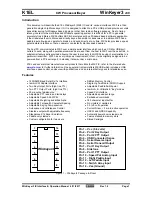
APPENDIX D LIST OF CAUTIONS
User’s Manual U16898EJ3V0UD
399
(13/17)
Chapter
Classification
Function Details
of
Function
Cautions Page
Hard
The wait time after the STOP mode is released does not include the time from the
release of the STOP mode to the start of clock oscillation (“a” in the figure below),
regardless of whether STOP mode was released by reset signal generation or
interrupt generation.
p. 229
OSTS:
Oscillation
stabilization
time select
register
The oscillation stabilization time that elapses on power application or after
release of reset is selected by the option byte. For details, refer to CHAPTER 17
OPTION BYTE.
p. 229
HALT mode
setting and
operating
statuses
Because an interrupt request signal is used to clear the standby mode, if there is
an interrupt source with the interrupt request flag set and the interrupt mask flag
clear, the standby mode is immediately cleared if set.
p. 230
Chapter 13
Soft
Standby
function
STOP mode
setting and
operating
statuses
Because an interrupt request signal is used to clear the standby mode, if there is
an interrupt source with the interrupt request flag set and the interrupt mask flag
reset, the standby mode is immediately cleared if set. Thus, in the STOP mode,
the normal operation mode is restored after the STOP instruction is executed and
then the operation is stopped for 34
µ
s (TYP.) (after an additional wait time for
stabilizing the oscillation set by the oscillation stabilization time select register
(OSTS) has elapsed when crystal/ceramic oscillation is used).
p. 233
For an external reset, input a low level for 2
µ
s or more to the RESET pin.
p. 237
During reset signal generation, the system clock and low-speed internal
oscillation clock stop oscillating.
p. 237
When the RESET pin is used as an input-only port pin (P34), the 78K0S/KA1+ is
reset if a low level is input to the RESET pin after reset is released by the POC
circuit and before the option byte is referenced again. The reset status is
retained until a high level is input to the RESET pin.
p. 237
−
The LVI circuit is not reset by the internal reset signal of the LVI circuit.
p. 238
Timing of reset
by overflow of
watchdog timer
The watchdog timer is also reset in the case of an internal reset of the watchdog
timer.
p. 240
Chapter 14
Hard
Reset
function
RESF: Reset
control flag
register
Do not read data by a 1-bit memory manipulation instruction.
p. 244
Soft
If an internal reset signal is generated in the POC circuit, the reset control flag
register (RESF) is cleared to 00H.
p. 245
Hard
Functions of
power-on-clear
circuit
Because the detection voltage (V
POC
) of the POC circuit is in a range of 2.1 V
±
0.1
V, use a voltage in the range of 2.2 to 5.5 V.
p. 245
Chapter 15
Soft
Power-
on-clear
circuit
Cautions for
power-on-clear
circuit
In a system where the supply voltage (V
DD
) fluctuates for a certain period in the
vicinity of the POC detection voltage (V
POC
), the system may be repeatedly reset
and released from the reset status. In this case, the time from release of reset to
the start of the operation of the microcontroller can be arbitrarily set by taking the
following action.
p. 247
To stop LVI, follow either of the procedures below.
•
When using 8-bit manipulation instruction: Write 00H to LVIM.
•
When using 1-bit memory manipulation instruction: Clear LVION to 0.
p. 250
LVIM: Low-
voltage detect
register
Be sure to set bits 2 to 6 to 0.
p. 250
Chapter 16
Soft
Low-
voltage
detector
LVIS: Low-
voltage
detection level
select register
Bits 4 to 7 must be set to 0.
p. 251











































